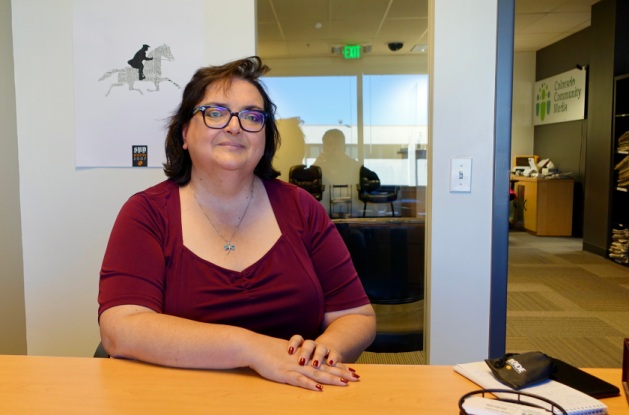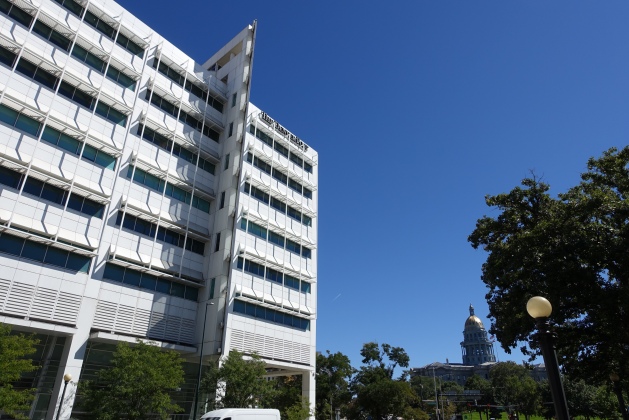
Donald Trump at the Air Force Academy Commencement in Colorado Springs in 2019. Photo by Trump White House Archived.
Following the Colorado Supreme Court’s ruling that Donald Trump has disqualified himself from appearing on the state’s Republican primary ballot, I thought I’d check in with the Denver media to see how they covered it. I started with The Colorado Sun, a digital startup that is one of the projects Ellen Clegg and I write about in our forthcoming book, “What Works in Community News.”
The Sun has a lengthy account by its chief political reporter, Jesse Paul. His story plays it straight, although it’s informed by his deep knowledge of the players in Colorado. What stands out to me is that the court went to some lengths to determine that Trump did, in fact, try to foment an insurrection on Jan. 6, 2021. Under the 14th Amendment, insurrectionists may not run for federal office, although that clause is the subject of many different interpretations. Paul quotes from the majority decision:
The record amply established that the events of Jan. 6 constituted a concerted and public use of force or threat of force by a group of people to hinder or prevent the U.S. government from taking the actions necessary to accomplish the peaceful transfer of power in this country. Under any viable definition, this constituted an insurrection.
The Colorado court’s decision will almost certainly be heard by the U.S. Supreme Court. If it’s upheld, then Trump would be banned not just from the state’s primary ballot but also — should he be the Republican nominee — the general election ballot in November 2024. Other states are considering the same action.
In The Denver Post, the city’s legacy daily newspaper, reporter Nick Coltrain interviews University of Colorado law professor Doug Spencer, who says that the purpose of the Colorado lawsuit that resulted in Tuesday’s ruling is to ensure that Trump can’t be elected to a second term next fall. Spencer told Coltrain that the lawsuit “was never really about keeping Trump’s name off Colorado’s ballot, because he was never going to win our electoral votes. It was about using our state law to get a ruling like this — and maybe now other courts will look at this and maybe not be so skittish.”
Colorado Public Radio, which may be the state’s largest news organization, takes on an issue that is sure to be raised by Trump’s lawyers and supporters: How can a state court find that Trump engaged in an insurrection given that there has been no federal finding to that effect? After all, the Senate failed to convict Trump after the House impeached him on what was essentially an insurrection case; he has not yet gone to trial on insurrection-related criminal charges; and there has been no congressional resolution passed by both branches finding that he tried to overturn the election.
But Bente Berkeland’s story for Colorado Public Radio notes the majority decision finds that Section 3 of the 14th Amendment does not require any further legal proceedings in order for its provisions to take effect. She writes that the decision…
…also reaffirms that, under Colorado law, the court has jurisdiction to bar disqualified candidates from the Republican Party’s primary ballot. They also concluded that the judicial branch is empowered to apply the clause.
“Congress does not need to pass implementing legislation for Section Three’s disqualification provision to attach,” the ruling states. “Section Three is, in that sense, self-executing.”
The city also has a second daily newspaper — The Denver Gazette, a digital-only outlet started several years ago by Colorado billionaire Philip Anschutz. The Gazette has a hard paywall, but I see that it leads today’s e-paper (there is no actual print edition) with a story on the court’s decision written by reporter Michael Karlik.
So now it’s on to the U.S. Supreme Court. Just as a layperson, it seems to me that the most significant issue before the Supremes is whether they can determine on their own authority that Trump engaged in an attempted insurrection or if instead they’re constrained by the lack of a congressional determination or a criminal conviction. We may assume that Trump begins with two aces in the hole: Justices Clarence Thomas and Sam Alito. Can he get to five?
Still, the Colorado decision was a landmark of sorts. As Paul wrote in the Sun: “The Colorado Supreme Court ruling marks the first time that the insurrection clause has been used to block a presidential candidate from appearing on the ballot.” That’s a dubious distinction in a long line of dubious distinctions for Trump, who, depending on how quickly the courts can move, might not only be disqualified from running but could also be sitting in a prison cell by Election Day.











Two Alden papers, the Boston Herald and The Denver Post, will end commenting
By Dan Kennedy
On June 27, 2023
In Media
Royalty-free photo via Wallpaper Flare
At least two daily newspapers owned by Alden Global Capital’s MediaNews Group will end reader comments on July 1.
The Boston Herald announced the move earlier today, saying that the change was being made to “dramatically speed up the performance of the website” as well as on its mobile platforms. The Denver Post took the same action last week, although editor Lee Ann Colacioppo cited bad behavior rather than technology, writing that the comment section has become “an uncivil place that drives readers away and opens those trying to engage in thoughtful conversation to hateful, personal attacks.”
Both papers emphasized that readers will still be able to talk back at them through social media platforms.
Wondering if this were a MediaNews-wide action, I tried searching about a half-dozen papers in the 60-daily chain and could find no similar announcements. I found something else interesting as well. The eight larger dailies that comprise the Tribune Publishing chain, which Alden acquired a couple of years ago, are now included as part of MediaNews Group, although they are still listed separately as well. (A ninth, the Daily News of New York, was split off from Tribune and is being run as a separate entity.)
The moves by the Herald and the Post represent just the latest in the long, sad story of user comments. When they debuted about a quarter-century ago, they were hailed as a way of involving the audience — the “former audience,” as Dan Gillmor and Jay Rosen put it. The hope was that comments could even advance stories.
It turned out that comments were embraced mainly by the most sociopathic elements. Some publishers (including me for a while) required real names, but that didn’t really help. The only measure that ensures a civil platform is pre-screening — a comment doesn’t appear online until someone has read it and approved it. But that takes resources, and very few news organizations are willing to make the investment.
The best comments section I know of belongs to the New Haven Independent, where pre-screening has been the rule right from the start. Keeping out racist, homophobic hate speech opens up the forum for other voices to be heard. The New York Times engages in pre-screening as well.
So kudos to the Boston Herald and The Denver Post — and I hope other news outlets, including The Boston Globe, will follow suit.